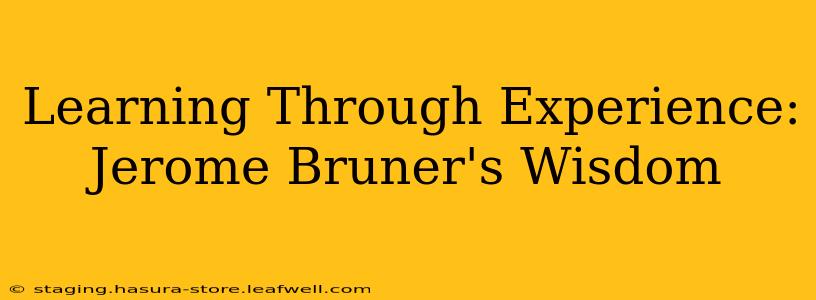Jerome Bruner, a towering figure in cognitive psychology, profoundly impacted our understanding of learning. His work emphasized the crucial role of experience in shaping knowledge and understanding, challenging traditional rote learning methods. Bruner's theories, particularly his focus on discovery learning and constructivism, remain highly relevant in modern education. This article delves into Bruner's key contributions, exploring how his insights continue to shape pedagogical approaches today.
What is Discovery Learning According to Bruner?
Bruner championed discovery learning, a pedagogical approach where learners actively construct their own knowledge through exploration and problem-solving. Unlike traditional methods that rely on passive reception of information, discovery learning encourages learners to engage with material, formulate hypotheses, test them, and draw their own conclusions. For Bruner, the process of discovery itself was paramount, fostering deeper understanding and retention than simply being told the answer. He believed this approach fostered critical thinking, problem-solving skills, and a lifelong love of learning.
What are Bruner's Three Modes of Representation?
Bruner proposed three modes of representation that children progress through as they develop cognitively:
- Enactive Representation (Action-Based): Infants primarily learn through actions and manipulations of objects. Learning is tied to physical experiences. For example, a baby learns about gravity by dropping toys.
- Iconic Representation (Image-Based): As children develop, they begin to represent their understanding through images and mental pictures. They can recall experiences even without physically enacting them. For instance, a child might draw a picture of a dog to represent their understanding of what a dog looks like.
- Symbolic Representation (Language-Based): This is the highest level, where abstract concepts are represented through symbols, language, and logic. Children can now use language and symbols to represent their understanding of complex ideas. This allows for more sophisticated problem-solving and abstract thinking.
Understanding these modes helps educators tailor their teaching methods to suit a child's developmental stage.
How Does Bruner's Theory Relate to Constructivism?
Bruner's work aligns closely with constructivist learning theories. Constructivism posits that learners actively construct their own understanding of the world, rather than passively absorbing information. Bruner's emphasis on discovery learning directly supports this, highlighting the importance of active participation and experience in building knowledge. Learners are not empty vessels to be filled, but active participants in the learning process, shaping their understanding based on their prior knowledge and experiences.
What are the Strengths and Weaknesses of Bruner's Theory?
Strengths:
- Promotes Active Learning: Encourages engagement and critical thinking.
- Develops Problem-Solving Skills: Learners develop the ability to approach challenges creatively.
- Enhances Retention: Active participation leads to deeper understanding and better memory retention.
- Fosters a Love of Learning: Discovery learning can be intrinsically motivating.
Weaknesses:
- Time-Consuming: Discovery learning can be more time-intensive than direct instruction.
- Requires Skilled Facilitation: Teachers need to carefully structure activities to guide learning effectively.
- Not Suitable for All Topics: Some topics may be better suited to direct instruction.
- Potential for Frustration: Learners may struggle if not properly supported.
How Can Bruner's Ideas Be Applied in the Classroom?
Bruner's ideas can be effectively implemented through various classroom strategies:
- Inquiry-Based Learning: Presenting open-ended questions and encouraging exploration.
- Problem-Based Learning: Using real-world problems as learning contexts.
- Hands-on Activities: Allowing learners to actively engage with materials and concepts.
- Collaborative Learning: Encouraging peer interaction and knowledge construction.
By incorporating these strategies, educators can create learning environments that foster active participation, critical thinking, and a deeper understanding of the subject matter, reflecting the core principles of Bruner's influential work. His emphasis on the experiential nature of learning continues to provide valuable insights for teachers and educators seeking to create engaging and effective learning experiences.

